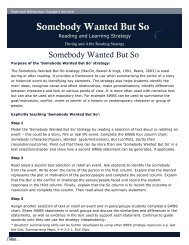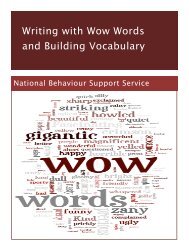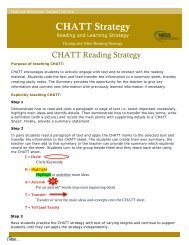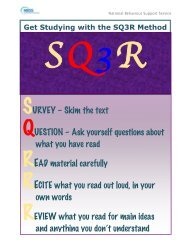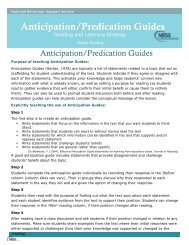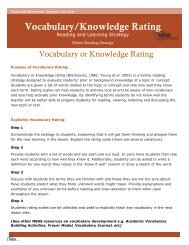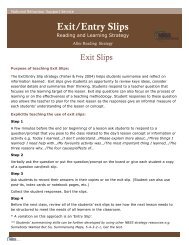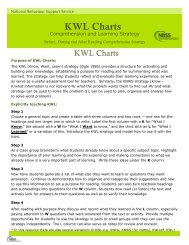Summarising Maps & Organisers - NBSS
Summarising Maps & Organisers - NBSS
Summarising Maps & Organisers - NBSS
Create successful ePaper yourself
Turn your PDF publications into a flip-book with our unique Google optimized e-Paper software.
National Behaviour Support Service<br />
<strong>Summarising</strong> <strong>Maps</strong> & <strong>Organisers</strong><br />
Reading and Learning Strategy<br />
After Reading Strategy<br />
<strong>Summarising</strong> <strong>Maps</strong> and <strong>Organisers</strong><br />
Purpose of using summarising maps and organisers:<br />
Effective summarising leads to an increase in student learning. <strong>Summarising</strong> requires students to<br />
focus on the main ideas of a text and to decide what is important without omitting key ideas.<br />
The goal of summarisation is to capture the essence of the text clearly and concisely. Using<br />
summarising maps, mind maps and other graphic organisers helps students learn the skill of<br />
summarising. <strong>Maps</strong>/organisers help students represent information visually in a clear, logical<br />
manner, it helps them organise the key ideas as well as aiding the recall of information.<br />
Explicitly teaching summarising maps and organisers:<br />
Step 1<br />
Explain the purpose and benefits of using map/organisers. Tell students that using a visual<br />
organiser can aid in retention, comprehension and recall of information to be learned.<br />
Step 2<br />
Introduce a specific organiser by describing its purpose (e.g. mind map – for summing up a topic<br />
and its form (e.g. center circle with coloured lines extending from it with pictures and symbols).<br />
Step 3<br />
Explain and model how to use the organiser with general information first. For example My<br />
Hobbies. Then with subject specific information.<br />
Step 4<br />
Have the students complete the map or organiser as a whole class with general information<br />
before using the organiser for subject specific information.<br />
Step 5<br />
Have students in pairs create or adapt their own organisers to summarise the main ideas in a<br />
lesson or topic.<br />
Step 6<br />
Provide opportunities for students to use various organisers to summarise lesson content.<br />
<strong>Organisers</strong> can also be completed for homework.<br />
* Students’ summarising skills can be further developed by using other <strong>NBSS</strong> strategy resources e.g<br />
Somebody Wanted But So, Get the Gist, 5-4-3-2-1, Exit Slips.
Strategy – <strong>Summarising</strong> <strong>Maps</strong> & <strong>Organisers</strong> National Behaviour Support Service<br />
5Ws + 1H<br />
What did you learn today Complete the 5Ws and 1H organiser and see can you pick out the<br />
main ideas of the topic.<br />
What happened<br />
Where did it happen<br />
When did it happen<br />
Topic Map about<br />
Who was involved<br />
in the events<br />
How did it happen<br />
Why did it happen<br />
National Behaviour Support Service<br />
frichardson@nbss.ie<br />
2
Strategy – <strong>Summarising</strong> <strong>Maps</strong> & <strong>Organisers</strong> National Behaviour Support Service<br />
What’s the Big Idea<br />
‘Interesting’ Information<br />
‘Important’ Information<br />
Big Ideas from this piece of the text:<br />
National Behaviour Support Service<br />
frichardson@nbss.ie<br />
3
Strategy – <strong>Summarising</strong> <strong>Maps</strong> & <strong>Organisers</strong> National Behaviour Support Service<br />
What’s the Big Idea<br />
Key Topic<br />
is about…<br />
Main Ideas:<br />
Essential Details<br />
Big Idea Summary Sentence/s<br />
National Behaviour Support Service<br />
frichardson@nbss.ie<br />
4
Strategy – <strong>Summarising</strong> <strong>Maps</strong> & <strong>Organisers</strong> National Behaviour Support Service<br />
(1) What I think or predict I<br />
will learn about based on the<br />
text features.<br />
Page/s:<br />
Title/Heading:<br />
Predict and Summarise<br />
1. Before you begin reading, use the clues of the text features listed in the first column to predict what<br />
you will learn. Based on these clues summarise what you predict you will learn from your reading.<br />
2. As you read, as well as after you read, identify and note down what you’ve learned. Then summarise or<br />
write the gist of what you’ve learned.<br />
3. After reading see how many of your predications were correct and what text features helped you the most.<br />
Topic:<br />
(2) After I read I learned…<br />
(3) Check for<br />
confirmation of<br />
your predications.<br />
What helped<br />
Subheadings:<br />
Bold:<br />
Italics:<br />
Charts/Diagrams:<br />
Pictures:<br />
In summary, from the above text<br />
feature clues I predict that…<br />
In summary I learned…<br />
National Behaviour Support Service<br />
frichardson@nbss.ie<br />
5
Strategy – <strong>Summarising</strong> <strong>Maps</strong> & <strong>Organisers</strong> National Behaviour Support Service<br />
Q Chart Summary (A)<br />
1.<br />
Skim through the chapter and write<br />
down key words and phrases (Hint:<br />
some of these words might be<br />
highlighted, bolded, italicized)<br />
2.<br />
As you read each paragraph or section write a definition<br />
of the key word or phrase.<br />
National Behaviour Support Service<br />
frichardson@nbss.ie<br />
6
Strategy – <strong>Summarising</strong> <strong>Maps</strong> & <strong>Organisers</strong> National Behaviour Support Service<br />
Q Chart Summary (B)<br />
3. Turn the headings and<br />
subheadings in your textbook<br />
into questions in this column.<br />
4. As you read write notes in this column that help<br />
you answer the questions you have asked.<br />
3. Retell or summarise what you have read.<br />
National Behaviour Support Service<br />
frichardson@nbss.ie<br />
7
Strategy – <strong>Summarising</strong> <strong>Maps</strong> & <strong>Organisers</strong> National Behaviour Support Service<br />
Summary PYRAMID<br />
After reading or listening think of words you can use to summarise what you learned.<br />
Follow the directions on each line below to complete your summary.<br />
One word to describe the topic<br />
Two words to describe subheadings of the topic<br />
Three words to describe what you already knew about the topic<br />
Four words to describe what you learned<br />
Five words to describe other knowledge that connects or links to this new knowledge/information<br />
One sentence that summarises the most important information.<br />
National Behaviour Support Service<br />
frichardson@nbss.ie<br />
8
Strategy – <strong>Summarising</strong> <strong>Maps</strong> & <strong>Organisers</strong> National Behaviour Support Service<br />
Main Idea PYRAMID<br />
Final Main<br />
Idea<br />
Statement<br />
Main Idea<br />
Statement 1<br />
Main Idea<br />
Statement 2<br />
Subtopic Subtopic Subtopic<br />
National Behaviour Support Service<br />
frichardson@nbss.ie<br />
9
Strategy – <strong>Summarising</strong> <strong>Maps</strong> & <strong>Organisers</strong> National Behaviour Support Service<br />
66 Word Summary<br />
Read the entire selection (section/page.). Then reread and highlight main ideas, keywords or phrases.<br />
Then write a summary in 66 words. Use one word in each square. You must use complete sentences.<br />
National Behaviour Support Service<br />
frichardson@nbss.ie<br />
10
Strategy – <strong>Summarising</strong> <strong>Maps</strong> & <strong>Organisers</strong> National Behaviour Support Service<br />
Summary Frames<br />
Although I already knew that ___________________________________ I learned some<br />
new information about __________________________________________________________.<br />
I learned that ___________________________________________________________________.<br />
I also discovered that ___________________________________________________________.<br />
Another fact I learned __________________________________________________________.<br />
However, the most important thing I learned was ________________________________<br />
______________________________________________________________________________.<br />
I found _____________________________________ interesting for several reasons.<br />
I discovered that _______________________________________________________________.<br />
I also learned that ______________________________________________________________ and<br />
that _________________________________________________________________________ .<br />
Finally, I _______________________________________________________________________.<br />
As you can see __________________________________________________________________<br />
________________________________________________________________________________.<br />
National Behaviour Support Service<br />
frichardson@nbss.ie<br />
11
Strategy – <strong>Summarising</strong> <strong>Maps</strong> & <strong>Organisers</strong> National Behaviour Support Service<br />
Summary Burger<br />
Main Idea/topic:<br />
Detail:<br />
Detail:<br />
Detail:<br />
Closing sentence:<br />
National Behaviour Support Service<br />
frichardson@nbss.ie<br />
12
Strategy – <strong>Summarising</strong> <strong>Maps</strong> & <strong>Organisers</strong> National Behaviour Support Service<br />
Summary Burger<br />
Main Idea/topic: The top bun stands for the topic sentence. The<br />
topic sentence should be general with no details. It should tell<br />
your reader the main idea of your paragraph.<br />
Detail: The meat, cheese and toppings stand for your supporting<br />
details. These details should support your main idea and should<br />
be in a clear, logical order.<br />
Detail:<br />
…more details to support your main idea<br />
Detail:<br />
…more details to support your main idea<br />
Closing sentence: The bottom bun stands for your concluding<br />
sentence of your paragraph. This is the sentence that wraps<br />
your paragraph together but does not introduce any new ideas.<br />
Sometimes this sentence is a restatement of your main idea.<br />
National Behaviour Support Service<br />
frichardson@nbss.ie<br />
13
Strategy – <strong>Summarising</strong> <strong>Maps</strong> & <strong>Organisers</strong> National Behaviour Support Service<br />
Word Wall Summary<br />
Write a summary of what you have read using as many main idea words<br />
/phrases as you can from the word wall below.<br />
Topic:<br />
My main ideas summary:<br />
National Behaviour Support Service<br />
frichardson@nbss.ie<br />
14
Strategy – <strong>Summarising</strong> <strong>Maps</strong> & <strong>Organisers</strong> National Behaviour Support Service<br />
Storyboard Summary<br />
Use pictures and/or words to create a summary of the main ideas.<br />
___________________________________<br />
___________________________________<br />
___________________________________<br />
___________________________________<br />
___________________________________<br />
___________________________________<br />
___________________________________<br />
___________________________________<br />
National Behaviour Support Service<br />
frichardson@nbss.ie<br />
15
Strategy – <strong>Summarising</strong> <strong>Maps</strong> & <strong>Organisers</strong> National Behaviour Support Service<br />
Compare and Contrast<br />
Use the organsier to show how two items/things are alike and how they are different.<br />
A.<br />
B.<br />
How they are alike<br />
How are they different<br />
National Behaviour Support Service<br />
frichardson@nbss.ie<br />
16
Strategy – <strong>Summarising</strong> <strong>Maps</strong> & <strong>Organisers</strong> National Behaviour Support Service<br />
Sequence Summary<br />
Use pictures and/or words to create a summary of the main ideas.<br />
National Behaviour Support Service<br />
frichardson@nbss.ie<br />
17
Strategy – <strong>Summarising</strong> <strong>Maps</strong> & <strong>Organisers</strong> National Behaviour Support Service<br />
The DAILY GIST<br />
Getting to the Heart of the Matter - since 1882-<br />
YOUR HEADLINE/HEADING HERE<br />
Summary picture here<br />
Write a 20/30 word summary of today’s<br />
topic/lesson.<br />
The DAILY GIST<br />
Getting to the Heart of the Matter - since 1882-<br />
National Behaviour Support Service<br />
frichardson@nbss.ie<br />
18
Strategy – <strong>Summarising</strong> <strong>Maps</strong> & <strong>Organisers</strong> National Behaviour Support Service<br />
Main Ideas from Today’s Lesson<br />
Linked information<br />
Linked information<br />
Important Idea 4:<br />
Important<br />
Idea 1:<br />
Topic:<br />
Textbook Pages:<br />
Important<br />
Idea 3:<br />
Important<br />
Idea 2:<br />
National Behaviour Support Service<br />
frichardson@nbss.ie<br />
19
Strategy – <strong>Summarising</strong> <strong>Maps</strong> & <strong>Organisers</strong> National Behaviour Support Service<br />
Topic Summary<br />
Create a summary of today’s lesson by answering as many questions as you<br />
can in the boxes below.<br />
Topic:<br />
Who<br />
What<br />
When<br />
Where<br />
Why<br />
How<br />
National Behaviour Support Service<br />
frichardson@nbss.ie<br />
20
Strategy – <strong>Summarising</strong> <strong>Maps</strong> & <strong>Organisers</strong> National Behaviour Support Service<br />
Summary of Main Ideas<br />
Where<br />
When<br />
Outcomes<br />
Key events<br />
Topic:<br />
What<br />
(main idea/problem)<br />
Why<br />
(Why is there a<br />
problem)<br />
National Behaviour Support Service<br />
frichardson@nbss.ie<br />
21
Strategy – <strong>Summarising</strong> <strong>Maps</strong> & <strong>Organisers</strong> National Behaviour Support Service<br />
5Ws + 1H<br />
What did you learn today Complete the 5Ws and 1H organiser and see can you pick out the<br />
main ideas of the topic. Add important detail to each point.<br />
WHO WHAT WHEN<br />
TITLE:<br />
WHERE WHY HOW<br />
National Behaviour Support Service<br />
frichardson@nbss.ie<br />
22
Strategy – <strong>Summarising</strong> <strong>Maps</strong> & <strong>Organisers</strong> National Behaviour Support Service<br />
The 5Ws of the Topic<br />
What did you learn about the topic Complete the 5Ws flower organiser and see can you pick out<br />
the main ideas of the topic. Then fill in some important details relating to each point in the<br />
petals.<br />
What<br />
Who<br />
When<br />
Why<br />
Where<br />
Two sentence summary:<br />
National Behaviour Support Service<br />
frichardson@nbss.ie<br />
23
Strategy – <strong>Summarising</strong> <strong>Maps</strong> & <strong>Organisers</strong> National Behaviour Support Service<br />
Who<br />
Who are the main<br />
characters and what are<br />
they like<br />
Story/Chapter Summary<br />
What <br />
What is the story about<br />
What is the problem and<br />
how is it sorted<br />
When<br />
When does the story take<br />
place<br />
Where<br />
Where does the story take<br />
place<br />
Why<br />
Why is there a problem<br />
National Behaviour Support Service<br />
frichardson@nbss.ie<br />
24
Strategy – <strong>Summarising</strong> <strong>Maps</strong> & <strong>Organisers</strong> National Behaviour Support Service<br />
Main Points of Topic<br />
Title<br />
National Behaviour Support Service<br />
frichardson@nbss.ie<br />
25
Strategy – <strong>Summarising</strong> <strong>Maps</strong> & <strong>Organisers</strong> National Behaviour Support Service<br />
Sequence of Key Events or Steps<br />
National Behaviour Support Service<br />
frichardson@nbss.ie<br />
26
Strategy – <strong>Summarising</strong> <strong>Maps</strong> & <strong>Organisers</strong> National Behaviour Support Service<br />
Chain of Events Summary<br />
Draw pictures in the boxes below to create a summary of the main events. Then<br />
write a summary based on your pictures.<br />
First: Second: Third: Outcome:<br />
Explanation of each event:<br />
National Behaviour Support Service<br />
frichardson@nbss.ie<br />
27
Strategy – <strong>Summarising</strong> <strong>Maps</strong> & <strong>Organisers</strong> National Behaviour Support Service<br />
Chain of Events Summary<br />
First…<br />
Then…<br />
Then…<br />
Then…<br />
And finally…<br />
National Behaviour Support Service<br />
frichardson@nbss.ie<br />
28
Strategy – <strong>Summarising</strong> <strong>Maps</strong> & <strong>Organisers</strong> National Behaviour Support Service<br />
Main Idea and Supporting Detail<br />
National Behaviour Support Service<br />
frichardson@nbss.ie<br />
29
Strategy – <strong>Summarising</strong> <strong>Maps</strong> & <strong>Organisers</strong> National Behaviour Support Service<br />
Key Ideas Web<br />
National Behaviour Support Service<br />
frichardson@nbss.ie<br />
30
Strategy – <strong>Summarising</strong> <strong>Maps</strong> & <strong>Organisers</strong> National Behaviour Support Service<br />
Compare and Contrast Summary<br />
National Behaviour Support Service<br />
frichardson@nbss.ie<br />
31
Strategy – <strong>Summarising</strong> <strong>Maps</strong> & <strong>Organisers</strong> National Behaviour Support Service<br />
Main Ideas Web<br />
National Behaviour Support Service<br />
frichardson@nbss.ie<br />
32
Strategy – <strong>Summarising</strong> <strong>Maps</strong> & <strong>Organisers</strong> National Behaviour Support Service<br />
Fishbone Summary<br />
National Behaviour Support Service<br />
frichardson@nbss.ie<br />
33
Strategy – <strong>Summarising</strong> <strong>Maps</strong> & <strong>Organisers</strong> National Behaviour Support Service<br />
Cause and Effect Summary<br />
Cause<br />
Topic:<br />
Effect<br />
National Behaviour Support Service<br />
frichardson@nbss.ie<br />
34
Strategy – <strong>Summarising</strong> <strong>Maps</strong> & <strong>Organisers</strong> National Behaviour Support Service<br />
Summary Bookmarks (front)<br />
Copy, back and laminate the bookmarks below.<br />
Sum It Up<br />
1. Preview the text by looking at <br />
headings, subheading, <br />
pictures, etc. Then read <br />
the selection carefully. <br />
2. Highlight VIPs (very important <br />
points). <br />
3. Create an A+ B + C topic <br />
sentence. <br />
A = identify the title or<br />
main heading<br />
B = select a strong verb<br />
(do not use is or was)<br />
C = finish your thought<br />
with the big idea.<br />
Get the Gist<br />
1. Preview the text by looking at <br />
headings, subheading, pictures, <br />
etc. <br />
2. Then read the selection <br />
carefully. <br />
3. Highlight the who, what, when, <br />
where, why and how of the text. <br />
!<br />
4. Now add on your VIPs. Be sure <br />
to write them as complete <br />
sentences. <br />
4. Write a 20 word ‘gist’ summary <br />
using the information you have <br />
highlighted. <br />
National Behaviour Support Service<br />
frichardson@nbss.ie<br />
35
Strategy – <strong>Summarising</strong> <strong>Maps</strong> & <strong>Organisers</strong> National Behaviour Support Service<br />
Sum It Up<br />
1. Preview the text by looking at headings, sub <br />
heading, pictures, diagrams, etc. Then read the text <br />
carefully. <br />
2. Highlight VIPs (very important points). <br />
3. Create an A+ B + C topic sentence. <br />
A=Identify the title or main heading <br />
B=Select a strong verb (don’t use is or was) <br />
C=Finish your thought with the big idea. <br />
4. Now add on your VIPs. Be <br />
sure to write them as complete <br />
sentences. <br />
National Behaviour Support Service<br />
frichardson@nbss.ie<br />
36
Strategy – <strong>Summarising</strong> <strong>Maps</strong> & <strong>Organisers</strong> National Behaviour Support Service<br />
Get the Gist<br />
1. Preview the text by looking at headings, subheading, <br />
pictures, diagrams, etc. <br />
2. Then read the selection carefully. <br />
3. Highlight the who, what, when, where, why and how <br />
!<br />
of the text. <br />
4. Write a 20 word ‘gist’ summary using the information <br />
you have highlighted. <br />
National Behaviour Support Service<br />
frichardson@nbss.ie<br />
37
Strategy – <strong>Summarising</strong> <strong>Maps</strong> & <strong>Organisers</strong> National Behaviour Support Service<br />
National Behaviour Support Service (<strong>NBSS</strong>) <br />
Navan Education Centre <br />
Athlumney <br />
Navan <br />
Co. Meath <br />
Telephone: +353 46 909 3355 <br />
Fax: +353 46 909 3354 <br />
Email: nbss@ecnavan.ie <br />
Web: www.nbss.ie<br />
National Behaviour Support Service<br />
frichardson@nbss.ie<br />
38



